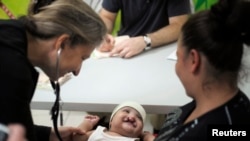Even before Daniel Truglio was born, his parents knew he had a cleft lip and a cleft palate.
John Truglio, Daniel’s father, said he and his wife, Roblyn, were nervous and scared.
“The first thing I thought about was, ‘Here? In the United States? Is it possible? That only happens in other places in the world,’” Truglio said.
The Truglios had four healthy children. They learned that cleft lip and cleft palate are two of the most common birth defects worldwide.
What is cleft lip or cleft palate?
A cleft is a gap in the lip or roof of the mouth. Some babies have both a cleft lip and a cleft palate. Depending on the severity, it can be life-threatening.
With a cleft lip, milk may come out of the baby’s nose while feeding. That’s because the barrier between the mouth and nose may be missing. Because of problems feeding, these children can be malnourished and have stunted growth. These babies can also face serious breathing, feeding, speech and hearing problems. They may not be able to suckle.
Children with a cleft palate often have frequent ear infections that can lead to hearing loss. They often have problems with speech. Children born with these defects are often stigmatized and subject to bullying.
Genetics can play a role, but no one knows why many babies are born with this defect. Scientists suspect environmental factors play a role.
Babies can have surgery to repair a cleft lip in the first year of life, ideally by the time they are 3 months old. Babies can have a cleft palate repaired between the ages of 18 months to 2 years.
Operation Smile
More than 35 years ago, Bill Magee, a dentist and plastic surgeon, traveled to the Philippines to treat children with this condition. He eventually founded Operation Smile to help even more.
“When people don’t have access to surgery, their life is really going to be affected,” Magee told VOA.
Operation Smile relies on volunteers to bring this life-changing surgery to children in developing countries. Over the years, Magee says the mission has changed.
“Up until about 1999, all of our volunteers pretty much came out of the United States,” he said.
Today, he said, 80 percent of the organization’s volunteers are from the 70 or 80 countries that the charity serves.
Finding a cause
Other volunteer groups now do much the same work. Over the years, Operation Smile has branched out into research. Because of its work, scientists have been able to zero in on a gene that causes the cleft. Volunteers found two sisters and their brother with cleft lip and palate.
Researchers at the University of Southern California studied their genes to see if they could find one that all three children shared. Dr. Yang Chai led the study.
“Normally, you would only see one child in the family of three or four children that develop this birth defect. Finding this birth defect in every single child in a family is like catching lightning in a bottle, because it allowed us to pinpoint the gene mutation that is probably responsible,” Chai said.
Researchers also found the children’s father had the same genetic mutation. He, too, had a cleft lip and cleft palate. Researchers then replicated the genetic abnormality in mice.
“You discover a mutation in a human study, (but) then you go to an animal model to basically mimic the same mutation, and ... if the animal model also develops the same birth defects, you have some proof this (genetic mutation) is really responsible.”
All of the pups born from the mice with this genetic mutation had cleft lip and cleft palate.
Other causes
Chai said his research can help parents prepare for their children’s surgery. Ultimately, Chai hopes scientists will one day prevent children with this mutation from having cleft lip or palate. But that’s a long way off, and there are other risk factors.
Genetics plays a role in 30 percent of the cases of cleft lip and cleft palate. Scientists are still searching for other environmental risk factors.
Last spring, Daniel Truglio had his cleft palate repaired and another surgery on his mouth. He is getting speech therapy. Daniel was born with other associated birth defects and still faces more surgeries.
His parents want other parents to know that Daniel is as lovable as their other children, and their hopes for him are the same as their hopes for the others.
Roblyn Truglio said their only desire is that Daniel has a happy, wonderful life, and that he’s able to accomplish his dreams.








